Current Status and Outlook of Roadbed Slope Stability Research: Study Based on Knowledge Mapping Bibliometric Network Analysis
Abstract
1. Introduction
2. Data and Methods
2.1. Data Sources
2.2. Research Methodology
3. Literature Analysis and Discussion
3.1. Analysis of Publication Information
3.2. Co-Occurrence Network Measurement Analysis
3.2.1. Co-Occurrence Analysis of National and Institutional Networks
3.2.2. Keyword Co-Occurrence Analysis
3.2.3. Analysis of Highly Cited Literature
3.2.4. Author Co-Occurrence Analysis
3.3. Literature Clustering Analysis
3.3.1. Cluster Analysis of Co-Cited Journals
3.3.2. Keyword Clustering Analysis
- (1)
- Instability mechanisms and risk assessment and kinetic analyses (different research objectives)
- (2)
- Embankments and road riffles and artificial and natural slopes (different study objects)
- (3)
- Freeze–thaw and rainfall and climate change (different study conditions)
- (4)
- Numerical simulations and physical experiments and theoretical deduction (different research methods)
3.3.3. Three-Field Plot Analysis
3.4. Analysis of Research Hotspots and Current Situation
4. Discussion
4.1. Systematic Review
4.2. Limitations and Challenges of Technology
4.2.1. Limitations of Numerical Simulation Techniques
4.2.2. Inadequacy of the Combination of Methodology and Actual Working Conditions
4.2.3. Integration Aspects of Economic and Environmental Dimensions
4.3. Future Research Directions
5. Conclusions
- This paper uses knowledge mapping to reveal the hotspots and trends in global roadbed slope stability research. The key topics include stability, numerical simulation, rainfall, and freeze–thaw cycles. China dominates the field, with 46.58% of publications and collaborates closely with the US and the UK. The study numbers surged after 2019, driven by China’s transportation development initiatives and advances in numerical simulation. Some influential works include Intrieri’s landslide prediction research and Zhang’s work on permafrost slope stability. The leading author is SINGH TN, who has published 29 papers on slope destabilization mechanisms and risk assessment. These results form a comprehensive knowledge framework for the field.
- Although the existing numerical simulation techniques have cost advantages and advanced software support, they face accuracy and reliability challenges due to the lack of sufficient practical validation, and the differences between the different research methods and the assumptions are more significant under complex working conditions. Future research should focus on multi-field coupled conditions, strictly calibrate the parameters through field measurements and experimental validation, and emphasize the development of highly accurate numerical models for THMC multi-field coupling.
- The current research methods usually favor theoretical analysis and ignore the interactions in dynamic environments, such as hydrology, the climate, and human activities. This disconnect limits the direct applicability of theoretical predictions to practical slope stability assessment. Future research should focus on the dynamization and intelligence of roadbed slope stability prediction, which needs to further integrate artificial intelligence and big data technology and requires a combination of multiple research methods to achieve interdisciplinary collaboration.
- The current research on roadbed slope stability is still mainly focused on technical feasibility, and the systematic assessment of economic cost and environmental impact is very limited. Future research should emphasize a multi-criteria decision-making framework that balances the technical, economic, and environmental factors to ensure that infrastructure projects are in line with the goals of sustainable development, and frameworks such as Deep Innovation MCDM and LCA provide a pathway to address the sustainability of roadbed slopes.
Author Contributions
Funding
Institutional Review Board Statement
Informed Consent Statement
Data Availability Statement
Acknowledgments
Conflicts of Interest
References
- Strano, E.; Giometto, A.; Shai, S.; Bertuzzo, E.; Mucha, P.J.; Rinaldo, A. The Scaling Structure of the Global Road Network. R. Soc. Open Sci. 2017, 4, 170590. [Google Scholar] [CrossRef] [PubMed]
- Wu, Y.; Pang, Y.; Zhu, X. Evolution of Prediction Models for Road Surface Irregularity: Trends, Methods and Future. Constr. Build. Mater. 2024, 449, 138316. [Google Scholar] [CrossRef]
- Senserrick, T.; Ivers, R.; Stevenson, M. Road Traffic Injuries. In International Encyclopedia of Public Health, 3rd ed.; Quah, S.R., Ed.; Academic Press: Oxford, UK, 2025; pp. 787–801. ISBN 978-0-323-97280-2. [Google Scholar]
- Chen, T.; Zhang, G. Centrifuge Modeling of Pile-Supported Embankment on Soft Soil Base for Highway Widening. Soils Found. 2024, 64, 101422. [Google Scholar] [CrossRef]
- Ray, R.; Lazzari, M.; Ray, R.; Lazzari, M. Landslides—Investigation and Monitoring; IntechOpen: London, UK, 2020; ISBN 978-1-78985-824-2. [Google Scholar]
- Kinnell, P.I.A. The Influence of Time and Other Factors on Soil Loss Produced by Rain-Impacted Flow under Artificial Rainfall. J. Hydrol. 2020, 587, 125004. [Google Scholar] [CrossRef]
- Song, X.; Tan, Y. Experimental Study on Failure of Temporary Earthen Slope Triggered by Intense Rainfall. Eng. Fail. Anal. 2020, 116, 104718. [Google Scholar] [CrossRef]
- Chen, Z.; Xie, C.; Xiong, G.; Shen, J.; Yang, B. Using the Morgenstern-Price Method and Cloud Theory to Invert the Shear Strength Index of Tailings Dams and Reveal the Coupling Deformation and Failure Law under Extreme Rainfall. Sustainability 2023, 15, 6106. [Google Scholar] [CrossRef]
- Xie, C.; Chen, Z.; Xiong, G.; Yang, B.; Shen, J. Study on the Evolutionary Mechanisms Driving Deformation Damage of Dry Tailing Stack Earth-Rock Dam under Short-Term Extreme Rainfall Conditions. Nat. Hazards 2023, 119, 1913–1939. [Google Scholar] [CrossRef]
- Lan, T.; Zhang, R.; Yang, B.; Meng, X. Influence of Swelling on Shear Strength of Expansive Soil and Slope Stability. Front. Earth Sci. 2022, 10, 849046. [Google Scholar] [CrossRef]
- Niyomukiza, J.B.; Eisazadeh, A.; Tangtermsirikul, S. Recent Advances in Slope Stabilization Using Porous Vegetation Concrete in Landslide-Prone Regions: A Review. J. Build. Eng. 2023, 76, 107129. [Google Scholar] [CrossRef]
- Wei, L.; Zeng, Z.; Yan, J. Factors Affecting the Stability of Loess Landslides: A Review. Appl. Sci. 2024, 14, 2735. [Google Scholar] [CrossRef]
- Yong, C.; Dong, J.; Fei, G.; Bin, T.; Tao, Z.; Hao, F.; Li, W.; Qinghua, Z. Review of Landslide Susceptibility Assessment Based on Knowledge Mapping. Stoch. Environ. Res. Risk Assess. 2022, 36, 2399–2417. [Google Scholar] [CrossRef]
- Zheng, H.; Shi, Z.; Shen, D.; Peng, M.; Hanley, K.J.; Ma, C.; Zhang, L. Recent Advances in Stability and Failure Mechanisms of Landslide Dams. Front. Earth Sci. 2021, 9, 659935. [Google Scholar] [CrossRef]
- Xie, C.; Xiong, G.; Chen, Z. Using CFD to Simulate the Concentration of Polluting and Harmful Gases in the Roadway of Non-Metallic Mines Reveals Its Migration Law. Sustainability 2022, 14, 13349. [Google Scholar] [CrossRef]
- Lu, Z.; Tang, C.; Xian, S.; She, J.; Yao, H. Experimental Study on Site Filling of Sandy Soil for Railway Subgrade. Proc. Inst. Civ. Eng.-Geotech. Eng. 2023, 176, 49–57. [Google Scholar] [CrossRef]
- Liu, Z. Influence of Rainfall Characteristics on the Infiltration Moisture Field of Highway Subgrades. Road Mater. Pavement Des. 2015, 16, 635–652. [Google Scholar] [CrossRef]
- Baghbani, A.; Choudhury, T.; Costa, S.; Reiner, J. Application of Artificial Intelligence in Geotechnical Engineering: A State-of-the-Art Review. Earth-Sci. Rev. 2022, 228, 103991. [Google Scholar] [CrossRef]
- Huang, Z.; Shi, H.; Zhang, W.; Ma, S.; Gao, F.; Ma, M. Expansive Soil Embankment Filling and Cutting Treatment Technology: A Systematic Review. Adv. Mater. Sci. Eng. 2022, 2022, 4045620. [Google Scholar] [CrossRef]
- Sun, H.; Xie, M.; Cui, W.; Xie, X.; Zong, S. Research Progress of Loess Reinforcement Technology: A Bibliometric Network Analysis. Constr. Build. Mater. 2024, 436, 136942. [Google Scholar] [CrossRef]
- Zhang, L.; Ling, J.; Lin, M. Artificial Intelligence in Renewable Energy: A Comprehensive Bibliometric Analysis. Energy Rep. 2022, 8, 14072–14088. [Google Scholar] [CrossRef]
- Xu, X.; Chen, Q.; Zhu, Z. Evolutionary Overview of Land Consolidation Based on Bibliometric Analysis in Web of Science from 2000 to 2020. Int. J. Environ. Res. Public Health 2022, 19, 3218. [Google Scholar] [CrossRef]
- Liu, C.; Li, W.; Xu, J.; Zhou, H.; Li, C.; Wang, W. Global Trends and Characteristics of Ecological Security Research in the Early 21st Century: A Literature Review and Bibliometric Analysis. Ecol. Indic. 2022, 137, 108734. [Google Scholar] [CrossRef]
- Bukar, U.A.; Sayeed, M.S.; Razak, S.F.A.; Yogarayan, S.; Amodu, O.A.; Mahmood, R.A.R. A Method for Analyzing Text Using VOSviewer. MethodsX 2023, 11, 102339. [Google Scholar] [CrossRef] [PubMed]
- van Eck, N.J.; Waltman, L. Software Survey: VOSviewer, a Computer Program for Bibliometric Mapping. Scientometrics 2010, 84, 523–538. [Google Scholar] [CrossRef] [PubMed]
- Chen, Z.; Shi, D. The Atmospheric Environment Effects of the COVID-19 Pandemic: A Metrological Study. Int. J. Environ. Res. Public Health 2022, 19, 11111. [Google Scholar] [CrossRef]
- Shi, D.; Chen, Z.; Zhang, X.; Xie, C. Intelligent Mine Safety Risk Based on Knowledge Graph: Hotspots and Frontiers. Environ. Sci. Pollut. Res. 2024, 31, 20699–20713. [Google Scholar] [CrossRef]
- Waltman, L.; van Eck, N.J.; Noyons, E.C.M. A Unified Approach to Mapping and Clustering of Bibliometric Networks. J. Informetr. 2010, 4, 629–635. [Google Scholar] [CrossRef]
- Xue, Y.; Wang, J.; Xiao, J. Bibliometric Analysis and Review of Mine Ventilation Literature Published between 2010 and 2023. Heliyon 2024, 10, e26133. [Google Scholar] [CrossRef]
- Liu, Z.; Yin, Y.; Liu, W.; Dunford, M. Visualizing the Intellectual Structure and Evolution of Innovation Systems Research: A Bibliometric Analysis. Scientometrics 2015, 103, 135–158. [Google Scholar] [CrossRef]
- Zhao, S.; Zheng, J.; Yang, J. Stability Analysis of Embankment Slope Considering Water Absorption and Softening of Subgrade Expansive Soil. Water 2022, 14, 3528. [Google Scholar] [CrossRef]
- Cao, T.; Wang, P.; Qiu, Z.; Ren, J. Influence of Impulse Waves Generated by Rocky Landslides on the Pressure Exerted on Bank Slopes. J. Mt. Sci. 2021, 18, 1159–1176. [Google Scholar] [CrossRef]
- Pantelidis, L. A Critical Review of Highway Slope Instability Risk Assessment Systems. Bull. Eng. Geol. Environ. 2011, 70, 395–400. [Google Scholar] [CrossRef]
- Stokes, A.; Douglas, G.B.; Fourcaud, T.; Giadrossich, F.; Gillies, C.; Hubble, T.; Kim, J.H.; Loades, K.W.; Mao, Z.; McIvor, I.R.; et al. Ecological Mitigation of Hillslope Instability: Ten Key Issues Facing Researchers and Practitioners. Plant Soil 2014, 377, 1–23. [Google Scholar] [CrossRef]
- Zhou, W.; Li, C.; Zhao, W.; Stringer, L.C.; Fu, B. Spatial Distributions of Soil Nutrients Affected by Land Use, Topography and Their Interactions, in the Loess Plateau of China. Int. Soil Water Conserv. Res. 2024, 12, 227–239. [Google Scholar] [CrossRef]
- Hu, H.; Wang, D.; Deng, S. Analysis of the Scientific Literature’s Abstract Writing Style and Citations. Online Inf. Rev. 2021, 45, 1290–1305. [Google Scholar] [CrossRef]
- Huang, Y.; Bu, Y.; Ding, Y.; Lu, W. Exploring Direct Citations between Citing Publications. J. Inf. Sci. 2021, 47, 615–626. [Google Scholar] [CrossRef]
- Ide, K. The Skewed Impact of Highly Cited Articles on Journal Impact Factor. J. Med. Internet Res. 2023, 25, e45322. [Google Scholar] [CrossRef]
- Intrieri, E.; Carla, T.; Gigli, G. Forecasting the Time of Failure of Landslides at Slope-Scale: A Literature Review. Earth-Sci. Rev. 2019, 193, 333–349. [Google Scholar] [CrossRef]
- Chambers, J.E.; Gunn, D.A.; Wilkinson, P.B.; Meldrum, P.I.; Haslam, E.; Holyoake, S.; Kirkham, M.; Kuras, O.; Merritt, A.; Wragg, J. 4D Electrical Resistivity Tomography Monitoring of Soil Moisture Dynamics in an Operational Railway Embankment. Surf. Geophys. 2014, 12, 61–72. [Google Scholar] [CrossRef]
- Tang, L.; Cong, S.; Geng, L.; Ling, X.; Gan, F. The Effect of Freeze-Thaw Cycling on the Mechanical Properties of Expansive Soils. Cold Reg. Sci. Technol. 2018, 145, 197–207. [Google Scholar] [CrossRef]
- Jamsawang, P.; Yoobanpot, N.; Thanasisathit, N.; Voottipruex, P.; Jongpradist, P. Three-Dimensional Numerical Analysis of a DCM Column-Supported Highway Embankment. Comput. Geotech. 2016, 72, 42–56. [Google Scholar] [CrossRef]
- Zhang, M.; Pei, W.; Li, S.; Lu, J.; Jin, L. Experimental and Numerical Analyses of the Thermo-Mechanical Stability of an Embankment with Shady and Sunny Slopes in a Permafrost Region. Appl. Therm. Eng. 2017, 127, 1478–1487. [Google Scholar] [CrossRef]
- Singh, R.; Umrao, R.K.; Singh, T.N. Stability Evaluation of Road-Cut Slopes in the Lesser Himalaya of Uttarakhand, India: Conventional and Numerical Approaches. Bull. Eng. Geol. Environ. 2014, 73, 845–857. [Google Scholar] [CrossRef]
- Siddique, T.; Pradhan, S.P.; Vishal, V.; Mondal, M.E.A.; Singh, T.N. Stability Assessment of Himalayan Road Cut Slopes along National Highway 58, India. Environ. Earth Sci. 2017, 76, 759. [Google Scholar] [CrossRef]
- Basahel, H.; Mitri, H. Application of Rock Mass Classification Systems to Rock Slope Stability Assessment: A Case Study. J. Rock Mech. Geotech. Eng. 2017, 9, 993–1009. [Google Scholar] [CrossRef]
- Vishal, V.; Siddique, T.; Purohit, R.; Phophliya, M.K.; Pradhan, S.P. Hazard Assessment in Rockfall-Prone Himalayan Slopes along National Highway-58, India: Rating and Simulation. Nat. Hazards 2017, 85, 487–503. [Google Scholar] [CrossRef]
- Kundu, J.; Sarkar, K.; Tripathy, A.; Singh, T.N. Qualitative Stability Assessment of Cut Slopes along the National Highway-05 around Jhakri Area, Himachal Pradesh, India. J. Earth Syst. Sci. 2017, 126, 112. [Google Scholar] [CrossRef]
- Kainthola, A.; Singh, P.K.; Singh, T.N. Stability Investigation of Road Cut Slope in Basaltic Rockmass, Mahabaleshwar, India. Geosci. Front. 2015, 6, 837–845. [Google Scholar] [CrossRef]
- Pradhan, S.P.; Siddique, T. Stability Assessment of Landslide-Prone Road Cut Rock Slopes in Himalayan Terrain: A Finite Element Method Based Approach. J. Rock Mech. Geotech. Eng. 2020, 12, 59–73. [Google Scholar] [CrossRef]
- Liu, H.; Niu, F.; Niu, Y.; Xu, J.; Wang, T. Effect of Structures and Sunny-Shady Slopes on Thermal Characteristics of Subgrade along the Harbin-Dalian Passenger Dedicated Line in Northeast China. Cold Reg. Sci. Technol. 2016, 123, 14–21. [Google Scholar] [CrossRef]
- Sharma, L.K.; Umrao, R.K.; Singh, R.; Ahmad, M.; Singh, T.N. Stability Investigation of Hill Cut Soil Slopes along National Highway 222 at Malshej Ghat, Maharashtra. J. Geol. Soc. India 2017, 89, 165–174. [Google Scholar] [CrossRef]
- Su, H.-N.; Lee, P.-C. Mapping Knowledge Structure by Keyword Co-Occurrence: A First Look at Journal Papers in Technology Foresight. Scientometrics 2010, 85, 65–79. [Google Scholar] [CrossRef]
- Singh, D.; Singh, P.K.; Kainthola, A.; Pandey, H.K.; Kumar, S.; Singh, T.N. Analysis of Failure Pattern in Cut Slopes of Bedded Sandstone: A Case Study. Environ. Earth Sci. 2022, 81, 398. [Google Scholar] [CrossRef]
- Panthee, S.; Singh, P.K.; Kainthola, A.; Das, R.; Singh, T.N. Comparative Study of the Deformation Modulus of Rock Mass. Bull. Eng. Geol. Environ. 2018, 77, 751–760. [Google Scholar] [CrossRef]
- Panthee, S.; Singh, P.K.; Kainthola, A.; Das, R.; Singh, T.N. Comparative Study of the Deformation Modulus of Rock Masses—A Reply to the Comments Received from Gokceoglu (2018). Bull. Eng. Geol. Environ. 2018, 77, 763–766. [Google Scholar] [CrossRef]
- Singh, P.K.; Singh, K.K.; Singh, T.N. Slope Failure in Stratified Rocks: A Case from NE Himalaya, India. Landslides 2017, 14, 1319–1331. [Google Scholar] [CrossRef]
- Liu, Z.; Ai, S.; Sheng, M.; Xiao, J.; Wang, P.; Ai, Y.; Ai, X. phoD-Harboring Bacterial Community Assembly and Co-Occurrence in Soil Aggregates during Roadside Slope Restoration. Eur. J. Soil Biol. 2024, 122, 103641. [Google Scholar] [CrossRef]
- Ai, S.; Liu, Z.; Ai, X.; Pan, Y.; Ai, Y. China’s Road Slopes Need Long-Term Protection. Science 2024, 384, 967. [Google Scholar] [CrossRef] [PubMed]
- Zhang, M.; Lu, J.; Pei, W.; Lai, Y.; Yan, Z.; Wan, X. Laboratory Study on the Frost-Proof Performance of a Novel Embankment Dam in Seasonally Frozen Regions. J. Hydrol. 2021, 602, 126769. [Google Scholar] [CrossRef]
- Blashfield, R.K.; Aldenderfer, M.S. The Literature on Cluster Analysis. Multivar. Behav. Res. 1978, 13, 271–295. [Google Scholar] [CrossRef]
- Liu, R.-L.; Hsu, C.-K. Issue-Based Clustering of Scholarly Articles. Appl. Sci. 2018, 8, 2591. [Google Scholar] [CrossRef]
- Jollife, I.T.; Philipp, A. Some Recent Developments in Cluster Analysis. Phys. Chem. Earth 2010, 35, 309–315. [Google Scholar] [CrossRef]
- Zuo, Z.; Cheng, J.; Guo, H.; Li, Y. Knowledge Mapping of Research on Strategic Mineral Resource Security: A Visual Analysis Using CiteSpace. Resour. Policy 2021, 74, 102372. [Google Scholar] [CrossRef]
- Fan, Z.; Yang, C.; Lin, B.; Yang, Y.; Shi, Q. Convex Set-Oriented Singular Value Decomposition with Bounded Uncertainties. J. Comput. Appl. Math. 2024, 448, 115942. [Google Scholar] [CrossRef]
- Wang, J.; Xue, Y.; Xiao, J.; Shi, D. Diffusion Characteristics of Airflow and CO in the Dead-End Tunnel with Different Ventilation Parameters after Tunneling Blasting. Acs Omega 2023, 8, 36269–36283. [Google Scholar] [CrossRef] [PubMed]
- Lin, S.; Zheng, H.; Han, B.; Li, Y.; Han, C.; Li, W. Comparative Performance of Eight Ensemble Learning Approaches for the Development of Models of Slope Stability Prediction. Acta Geotech. 2022, 17, 1477–1502. [Google Scholar] [CrossRef]
- Zhu, C.; He, M.; Karakus, M.; Cui, X.; Tao, Z. Investigating Toppling Failure Mechanism of Anti-Dip Layered Slope Due to Excavation by Physical Modelling. Rock Mech. Rock Eng. 2020, 53, 5029–5050. [Google Scholar] [CrossRef]
- Qin, Y.; Yang, G.; Liu, B.; Xu, J. Study on Deformation and Failure Mechanism of Low-Dip Red Bed Slope with Soft-Hard Interbedded Structure: A Case Study of Chishui, China. Nat. Hazards 2024, 120, 10539–10557. [Google Scholar] [CrossRef]
- Li, L.; Liu, T.; Guo, Z.; Li, W.; Xia, Y. On the Effect of Rail-End Slope in Train Aerodynamics under Crosswind. Veh. Syst. Dyn. 2022, 60, 1888–1908. [Google Scholar] [CrossRef]
- Srinivasan, R.; Vasu, D.; Suputhra, S.A.; Hegde, R.; Ray, S.K.; Singh, S.K. A GIS-Based Spatial Prediction of Landslide Hazard Zones and Mapping in an Eastern Himalayan Hilly Region Using Large Scale Soil Mapping and Analytical Hierarchy Process. J. Indian Soc. Remote Sens. 2022, 50, 1915–1930. [Google Scholar] [CrossRef]
- Ye, P.; Yu, B.; Chen, W.; Feng, Y.; Zhou, H.; Luo, X.; Li, Y. Risk Assessment of Landslide and Rockfall Hazards in Hilly Region of Southwestern China: A Case Study of Qijiang, Wuxi and Chishui. Environ. Earth Sci. 2024, 83, 398. [Google Scholar] [CrossRef]
- Niu, F.; Luo, J.; Lin, Z.; Fang, J.; Liu, M. Thaw-Induced Slope Failures and Stability Analyses in Permafrost Regions of the Qinghai-Tibet Plateau, China. Landslides 2016, 13, 55–65. [Google Scholar] [CrossRef]
- Tai, B.-W.; Wu, Q.-B.; Xu, X.-M. Thermal and Hydrological Processes in Permafrost Slope Wetlands Affect Thermosyphon Embankment Stability. Adv. Clim. Change Res. 2024, 15, 680–694. [Google Scholar] [CrossRef]
- Qian, J.; Yu, Q.; You, Y.; Hu, J.; Guo, L. Analysis on Cooling Effect of New Hollow Concrete Brick Revetment under Gravel Pavement in Permafrost Regions. Cold Reg. Sci. Technol. 2013, 85, 15–21. [Google Scholar] [CrossRef]
- Kovchegov, Y.; Zaliapin, I. Horton Law in Self-Similar Trees. Fractals-Complex Geom. Patterns Scaling Nat. Soc. 2016, 24, 1650017. [Google Scholar] [CrossRef]
- Qin, Y.; Chen, Y.; Lai, J.; Qiu, J.; Wang, Z.; Liu, T.; Zan, W. Failures in Loess Slope-Tunnel System: An Overview of Trigging Sources, Acting Mechanism and Mitigation Strategies. Eng. Fail. Anal. 2024, 158, 107996. [Google Scholar] [CrossRef]
- Jiang, S.-H.; Huang, J.; Yao, C.; Yang, J. Quantitative Risk Assessment of Slope Failure in 2-D Spatially Variable Soils by Limit Equilibrium Method. Appl. Math. Model. 2017, 47, 710–725. [Google Scholar] [CrossRef]
- Li, D.-Q.; Yang, Z.-Y.; Cao, Z.-J.; Zhang, L.-M. Area Failure Probability Method for Slope System Failure Risk Assessment. Comput. Geotech. 2019, 107, 36–44. [Google Scholar] [CrossRef]
- Yan, J.; Chen, J.; Li, Y.; Li, Z.; Zhang, Y.; Zhou, X.; Mehmood, Q.; Liu, J.; Wang, Z. Kinematic-Based Failure Angle Analysis for Discontinuity-Controlled Rock Slope Instabilities: A Case Study of Ren Yi Peak Cluster in Fusong County, China. Nat. Hazards 2022, 111, 2281–2296. [Google Scholar] [CrossRef]
- Shu, S.; Ge, B.; Wu, Y.; Zhang, F. Probabilistic Assessment on 3D Stability and Failure Mechanism of Undrained Slopes Based on the Kinematic Approach of Limit Analysis. Int. J. Geomech. 2023, 23, 06022037. [Google Scholar] [CrossRef]
- Fang, K.; Jia, S.; Tang, H.; Zhou, R.; Kong, Z.; Fu, Y.; An, P.; Zhang, B.; Wu, Q. Arching Effect in Slopes under Excavation: Classification and Features. Eng. Geol. 2024, 337, 107563. [Google Scholar] [CrossRef]
- Huang, J.; Wen, H.; Hu, J.; Liu, B.; Zhou, X.; Liao, M. Deciphering Decision-Making Mechanisms for the Susceptibility of Different Slope Geohazards: A Case Study on a SMOTE-RF-SHAP Hybrid Model. J. Rock Mech. Geotech. Eng. 2024, 17, 1612–1630. [Google Scholar] [CrossRef]
- Zhang, Q.; Zhang, H.; Wang, L.; Li, Q.; Yu, H. Effect of Structural Characteristics on the Stability of Multi-Weak Rock Slopes Considering the Spatial Variability of Geotechnical Parameters. Sci. Rep. 2024, 14, 30618. [Google Scholar] [CrossRef] [PubMed]
- Qian, C.; Li, Y.; Vardon, P.J.; Shao, W.; Song, J.; Zhang, B.; Xu, N. Temporal Stability and Risk Analysis of Soil Slopes Subject to Rainfall: The Influence of Heterogeneity. Eng. Geol. 2025, 347, 107895. [Google Scholar] [CrossRef]
- Zuo, R.; Carranza, E.J.M. A Fractal Measure of Spatial Association between Landslides and Conditioning Factors. J. Earth Sci. 2017, 28, 588–594. [Google Scholar] [CrossRef]
- Huang, W.; Shao, S.; Liu, Y.; Xu, X.; Zhang, W.; Liu, Y. The Collapse Mechanism of Slope Rill Sidewall under Composite Erosion of Freeze-Thaw Cycles and Water. Sustainability 2024, 16, 4144. [Google Scholar] [CrossRef]
- Su, Y.; Li, P.; Ren, Z.; Xiao, L.; Zhang, H. Freeze-Thaw Effects on Erosion Process in Loess Slope under Simulated Rainfall. J. Arid Land 2020, 12, 937–949. [Google Scholar] [CrossRef]
- Ng, C.W.W.; Wang, Y.; Zhang, S.; Zhang, Q. Effects of Climate Change on Soil Embankments for Transport Infrastructure. Transp. Geotech. 2024, 48, 101324. [Google Scholar] [CrossRef]
- Yoshida, S.; Xiong, X.; Matsumoto, T. Experimental and Numerical Study on Reinforcement Effect of Plate Anchors or Flip Anchors on Model Slopes. Soils Found. 2023, 63, 101285. [Google Scholar] [CrossRef]
- Wang, H.; Bai, Y.; Huang, D. Study of Experimental and Numerical Simulation on the Influence of Gravel on the Interflow of Slope Land. Environ. Sci. Pollut. Res. 2024, 31, 11716–11726. [Google Scholar] [CrossRef]
- Shihabudheen, K.V.; Peethambaran, B. Landslide Displacement Prediction Technique Using Improved Neuro-Fuzzy System. Arab. J. Geosci. 2017, 10, 502. [Google Scholar] [CrossRef]
- Shihabudheen, K.; Pillai, G.N.; Peethambaran, B. Prediction of Landslide Displacement with Controlling Factors Using Extreme Learning Adaptive Neuro-Fuzzy Inference System (ELANFIS). Appl. Soft Comput. 2017, 61, 892–904. [Google Scholar] [CrossRef]
- Yang, Z.; Song, Z.; Ding, X.; Victoire, M.N.M.; Wahab, A.M.A.; Oumar, B.; Yang, F.; Ibrahim, A.Y.; Gao, Z.; Long, Z. Investigating Slope Stability of Multiple Stopes Prone to Instability in the Ziluoyi Iron Ore Mining Site. Sci. Rep. 2025, 15, 1900. [Google Scholar] [CrossRef]
- Kapp, P.; DeCelles, P.G. Mesozoic-Cenozoic Geological Evolution of the Himalayan-Tibetan Orogen and Working Tectonic Hypotheses. Am. J. Sci. 2019, 319, 159–254. [Google Scholar] [CrossRef]
- Hu, X.; Garzanti, E.; Wang, J.; Huang, W.; An, W.; Webb, A. The Timing of India-Asia Collision Onset—Facts, Theories, Controversies. Earth-Sci. Rev. 2016, 160, 264–299. [Google Scholar] [CrossRef]
- Mathian, M.; Aufort, J.; Braun, J.-J.; Riotte, J.; Selo, M.; Balan, E.; Fritsch, E.; Bhattacharya, S.; Allard, T. Unraveling Weathering Episodes in Tertiary Regoliths by Kaolinite Dating (Western Ghats, India). Gondwana Res. 2019, 69, 89–105. [Google Scholar] [CrossRef]
- Luo, Y.-X.; Zhu, Y.-H.; Yao, X.-Q. Knowledge Mapping of Exercise and Physical Activity Research in Older Adults: Hotspots, Bursts, and Trends of the Last Decade. Heliyon 2023, 9, e23181. [Google Scholar] [CrossRef] [PubMed]
- Zerouali, B.; Bailek, N.; Tariq, A.; Kuriqi, A.; Guermoui, M.; Alharbi, A.H.; Khafaga, D.S.; El-kenawy, E.-S.M. Enhancing Deep Learning-Based Slope Stability Classification Using a Novel Metaheuristic Optimization Algorithm for Feature Selection. Sci. Rep. 2024, 14, 21812. [Google Scholar] [CrossRef]
- Wang, Y.; Ni, S.-T.; Yang, F.-W.; Wang, Z.-X.; Zhang, H.; Ma, K.; Li, X.-J. Monitoring and Analysis of Dynamic Response for Open-Pit Mine with Inside Inclined Shafts under Train Loading. Metals 2021, 11, 1681. [Google Scholar] [CrossRef]
- Yang, H.; Huang, G.; Wei, Z.; Jiang, X.; Cao, Z. A Study on the Dynamic Response of a Timber-Frame Beam-Bamboo Anchor-Supported Roadbed Slope under Train Load. Appl. Sci. 2024, 14, 2426. [Google Scholar] [CrossRef]
- Przewlocki, J. Brief Literature Review and Classification System of Reliability Methods for Evaluating the Stability of Earth Slopes. Sustainability 2021, 13, 9090. [Google Scholar] [CrossRef]
- Zhang, X.; Yang, Q.; Ding, J.; Wang, Z. Entity Profiling in Knowledge Graphs. IEEE Access 2020, 8, 27257–27266. [Google Scholar] [CrossRef]
- Hogan, A.; Blomqvist, E.; Cochez, M.; D’Amato, C.; de Melo, G.; Gutierrez, C.; Kirrane, S.; Labra Gayo, J.E.; Navigli, R.; Neumaier, S.; et al. Knowledge Graphs. ACM Comput. Surv. 2021, 54, 71. [Google Scholar] [CrossRef]
- Liu, W.; Liu, J.; Wu, M.; Abbas, S.; Hu, W.; Wei, B.; Zheng, Q. Representation Learning over Multiple Knowledge Graphs for Knowledge Graphs Alignment. Neurocomputing 2018, 320, 12–24. [Google Scholar] [CrossRef]
- Xue, Y.; Chen, L.; Mu, Y.; Zeng, L.; Rezaeibagha, F.; Deng, R.H. Structured Encryption for Knowledge Graphs. Inf. Sci. 2022, 605, 43–70. [Google Scholar] [CrossRef]
- Pezo, C.; Hochbaum, D.; Godoy, J.; Asín-Achá, R. Automatic Algorithm Selection for Pseudo-Boolean Optimization with given Computational Time Limits. Comput. Oper. Res. 2025, 173, 106836. [Google Scholar] [CrossRef]
- Wang, X.; Lu, J.; Song, Z.; Zhou, Y.; Liu, T.; Zhang, D. From Past to Future: Bibliometric Analysis of Global Research Productivity on Nomogram (2000–2021). Front. Public Health 2022, 10, 997713. [Google Scholar] [CrossRef]
- Geng, Y.; Xiang, Q.; Gao, J.; Yan, Y.; Li, J. Progress and Framework of Clean Energy Production: Bibliometric Analysis from 2002 to 2022. Energy Strategy Rev. 2024, 52, 101270. [Google Scholar] [CrossRef]
- Li, T.-T.; Wang, K.; Sueyoshi, T.; Wang, D.D. ESG: Research Progress and Future Prospects. Sustainability 2021, 13, 11663. [Google Scholar] [CrossRef]
- Adolphe, K.; Noël, W.N.; Harmel, O.O.; Gampio, M.U.; Gonçalves, A.O.; Lacaba, R.G.; Florent, B. Comparative Study of Slope Soils Analysis by Using Limit Equilibrium and Finite Element Methods. Int. J. Geosci. 2022, 13, 1089–1102. [Google Scholar] [CrossRef]
- Yao, Y.; Xu, P.; Li, J.; Hu, H.; Qi, Q. Advancements and Applications of Life Cycle Assessment in Slope Treatment: A Comprehensive Review. Sustainability 2024, 16, 398. [Google Scholar] [CrossRef]
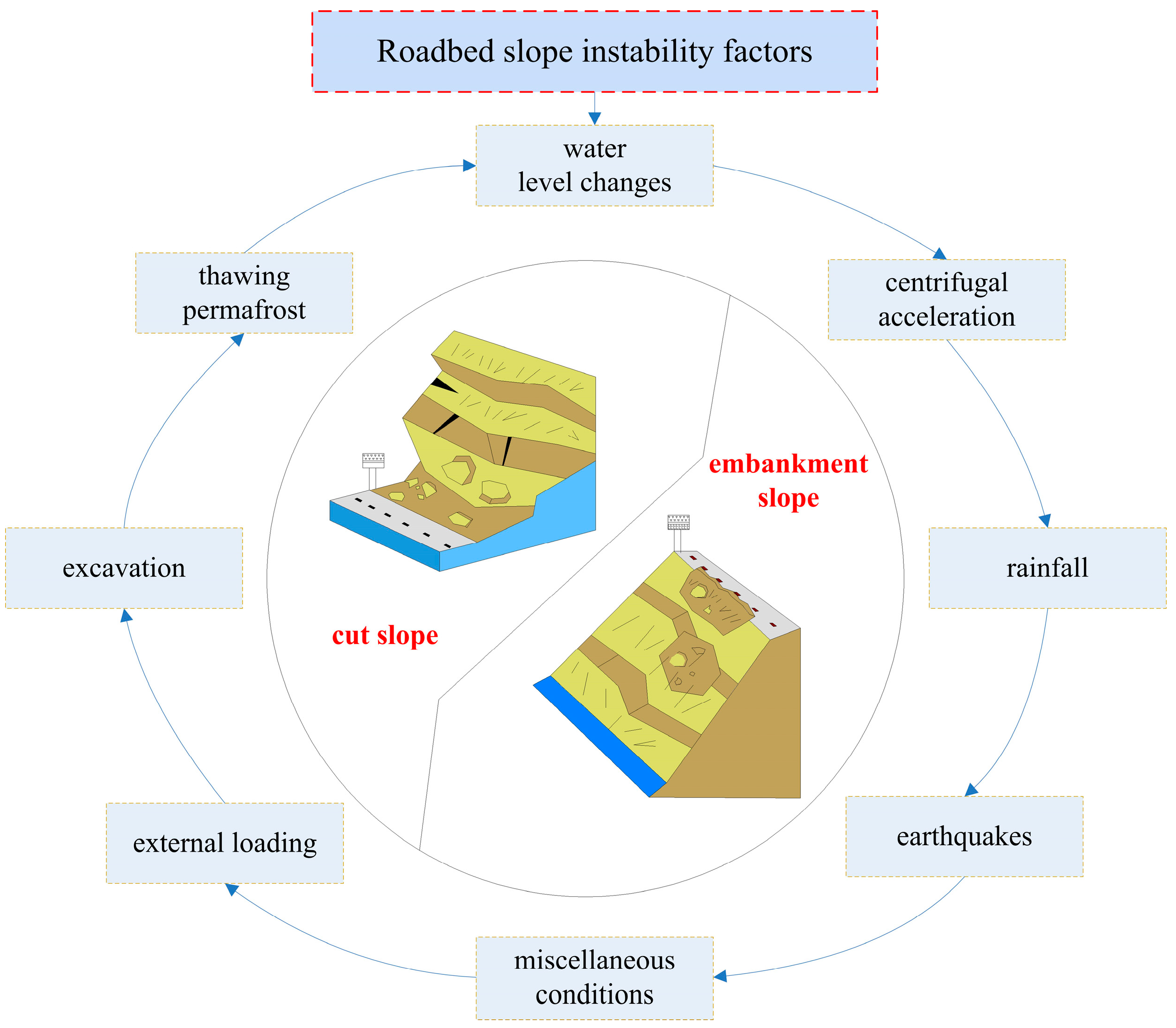
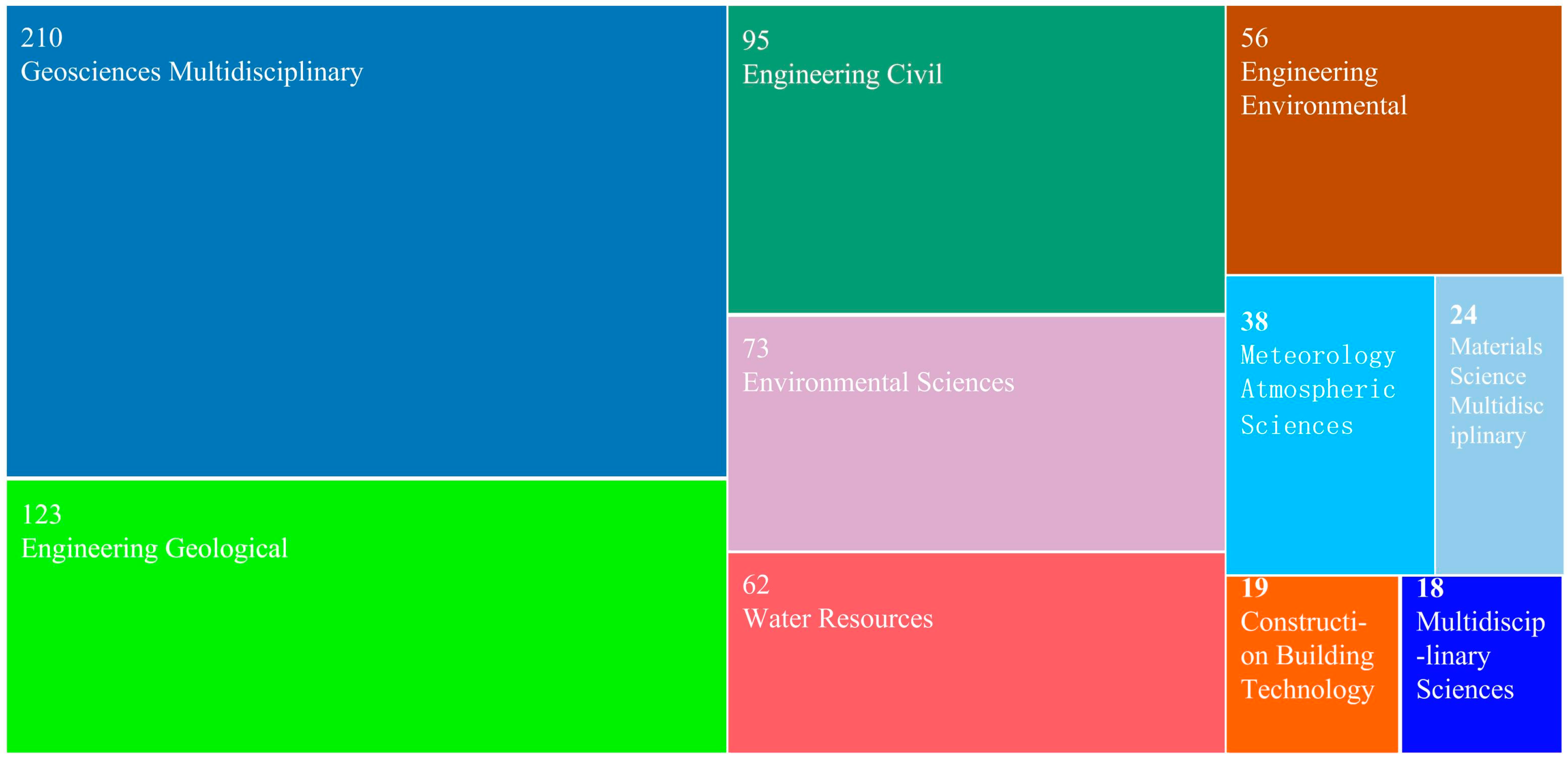
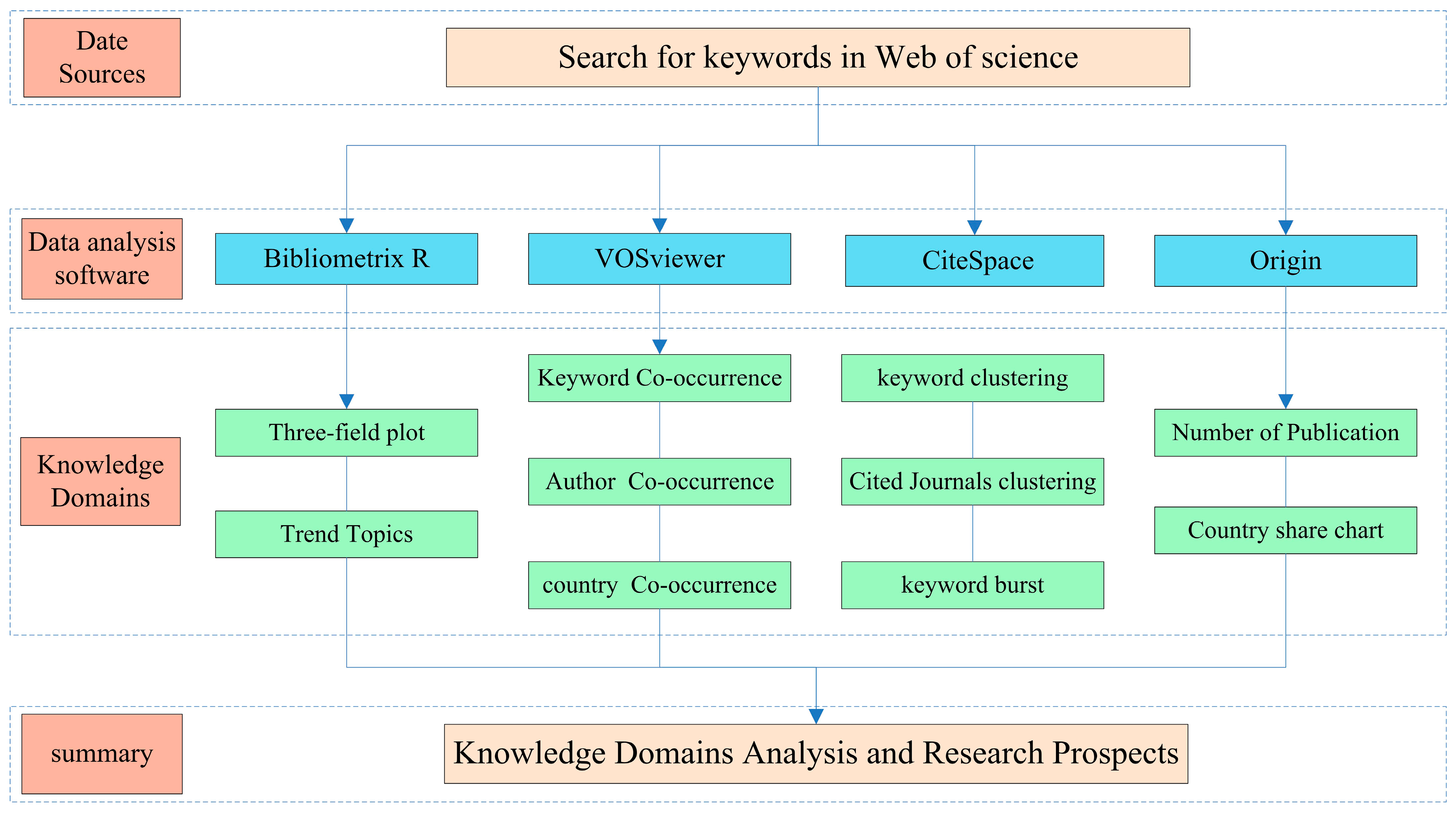
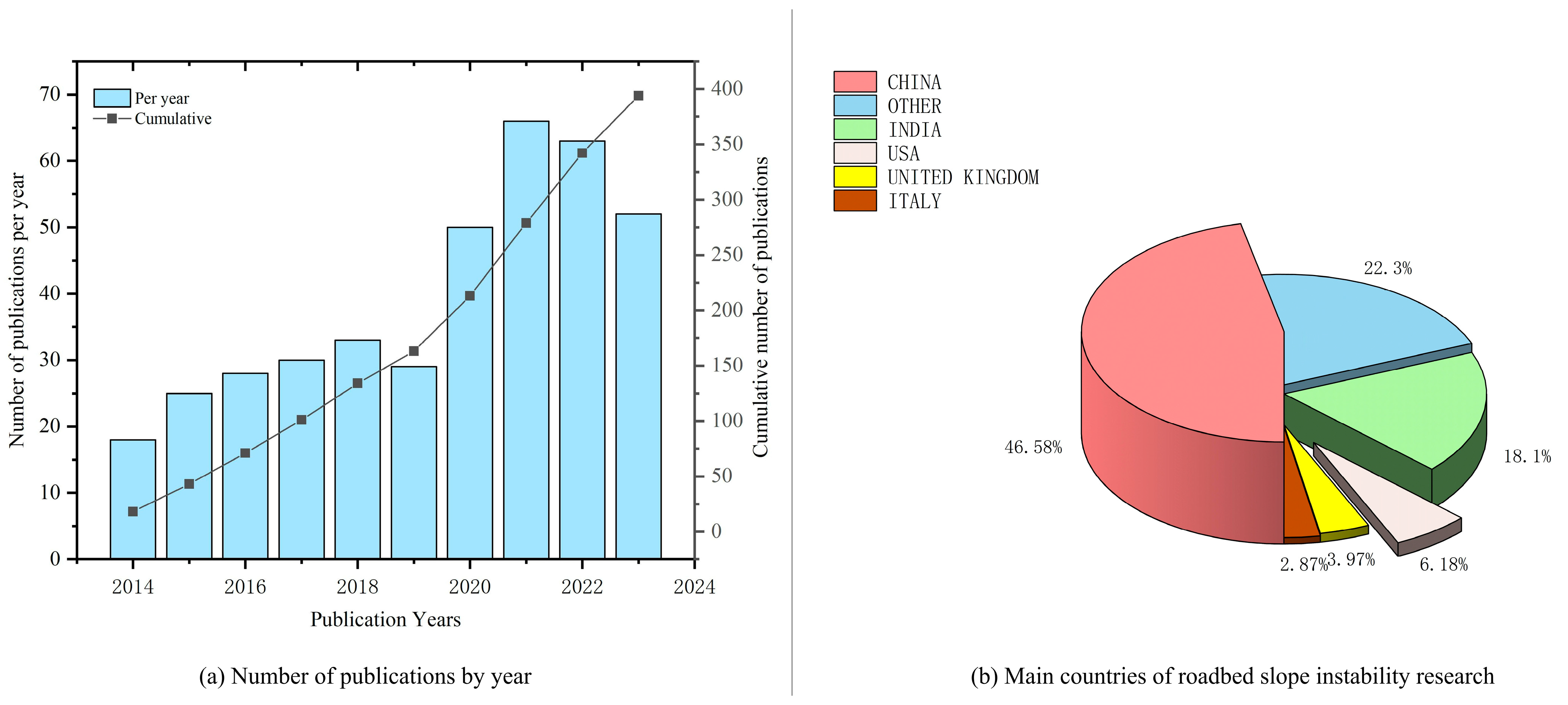
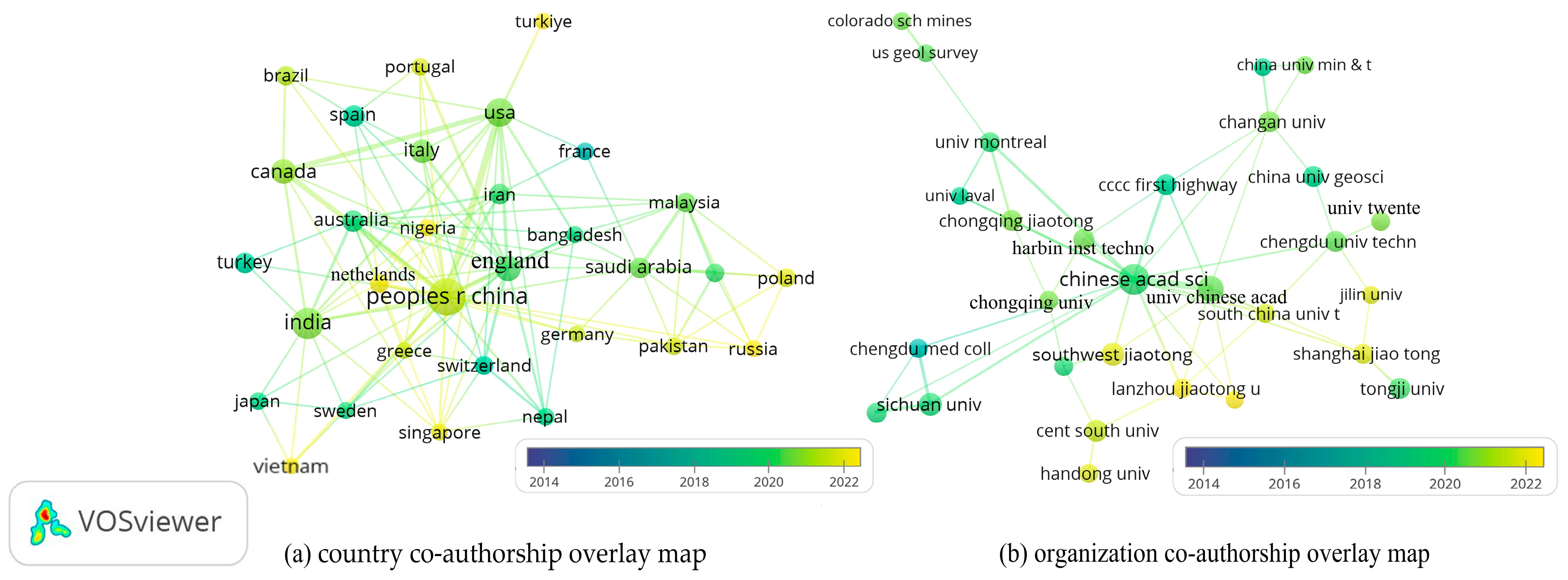
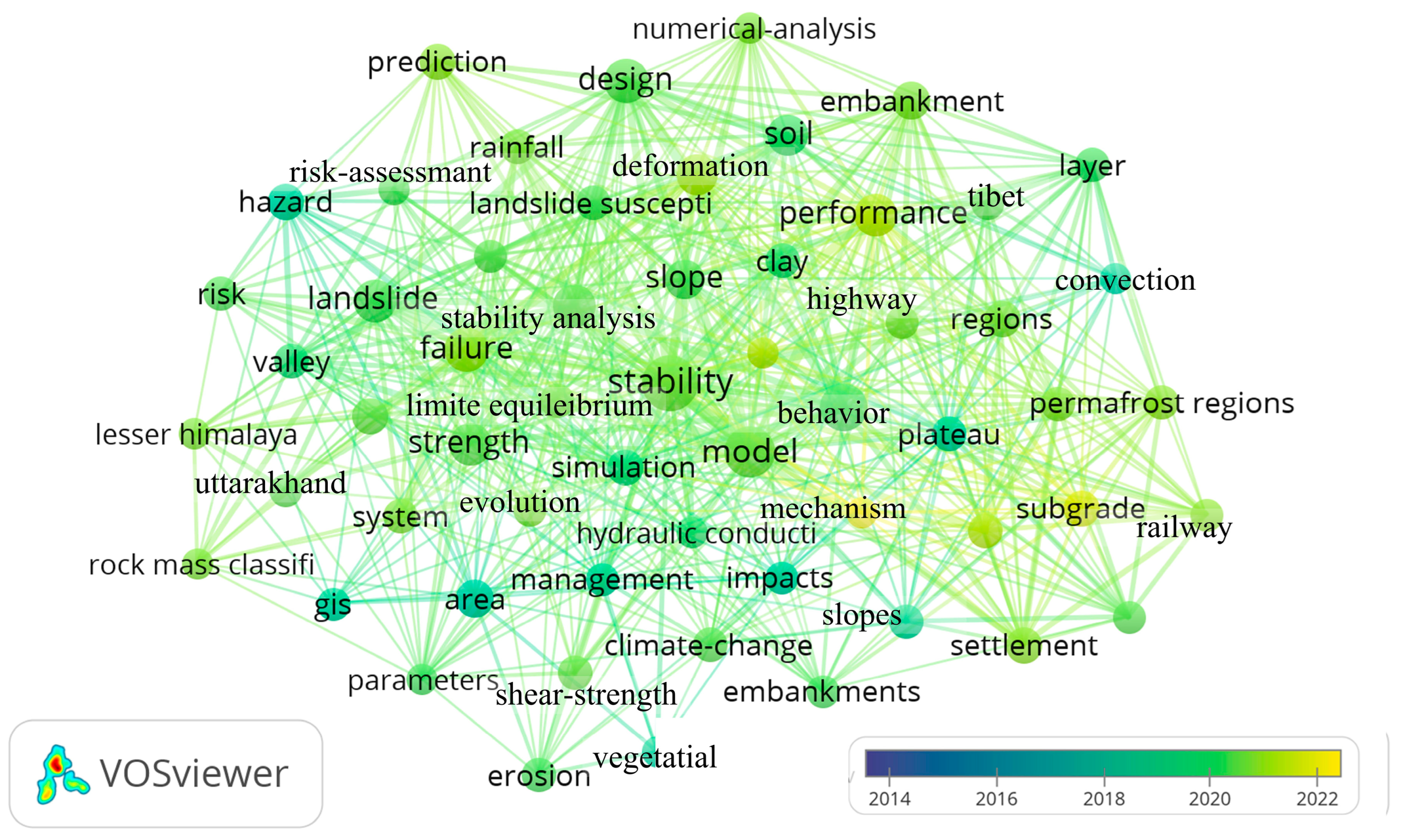
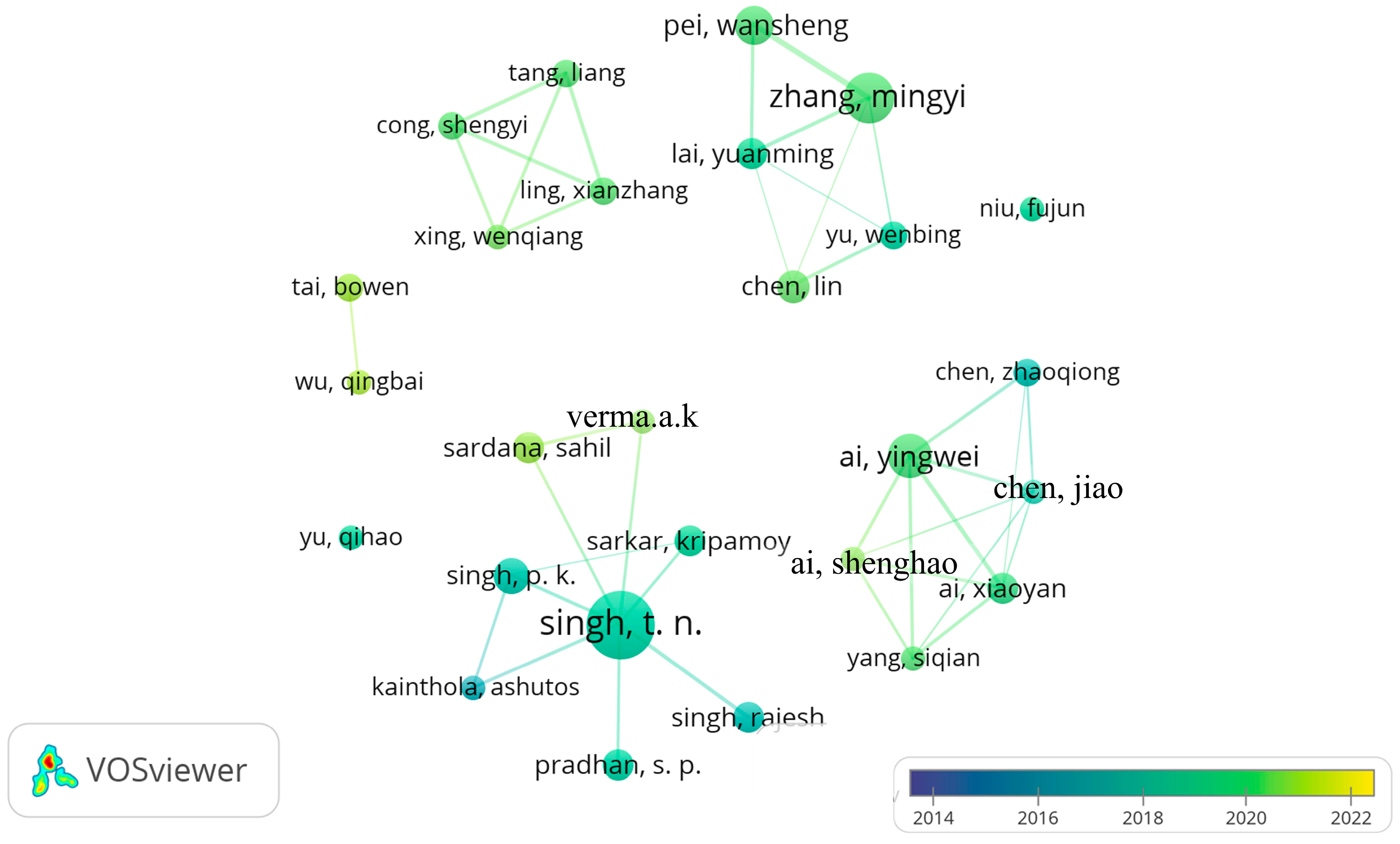
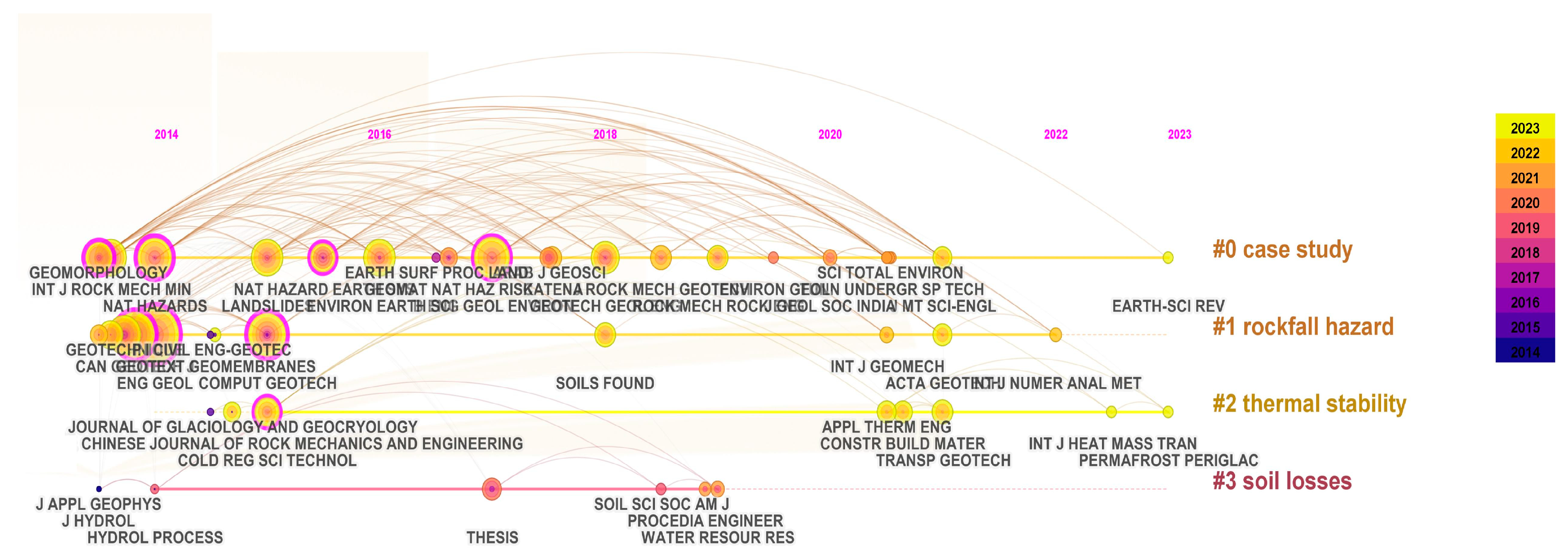
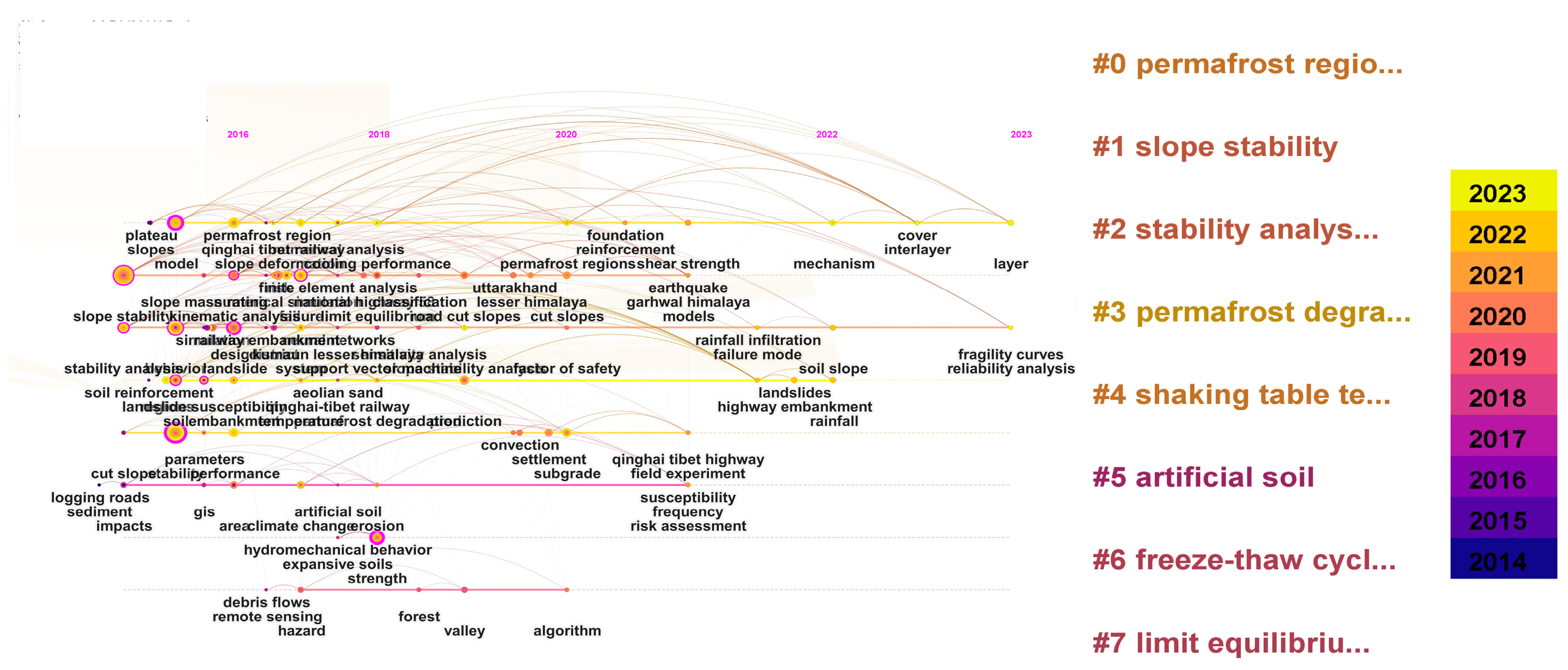
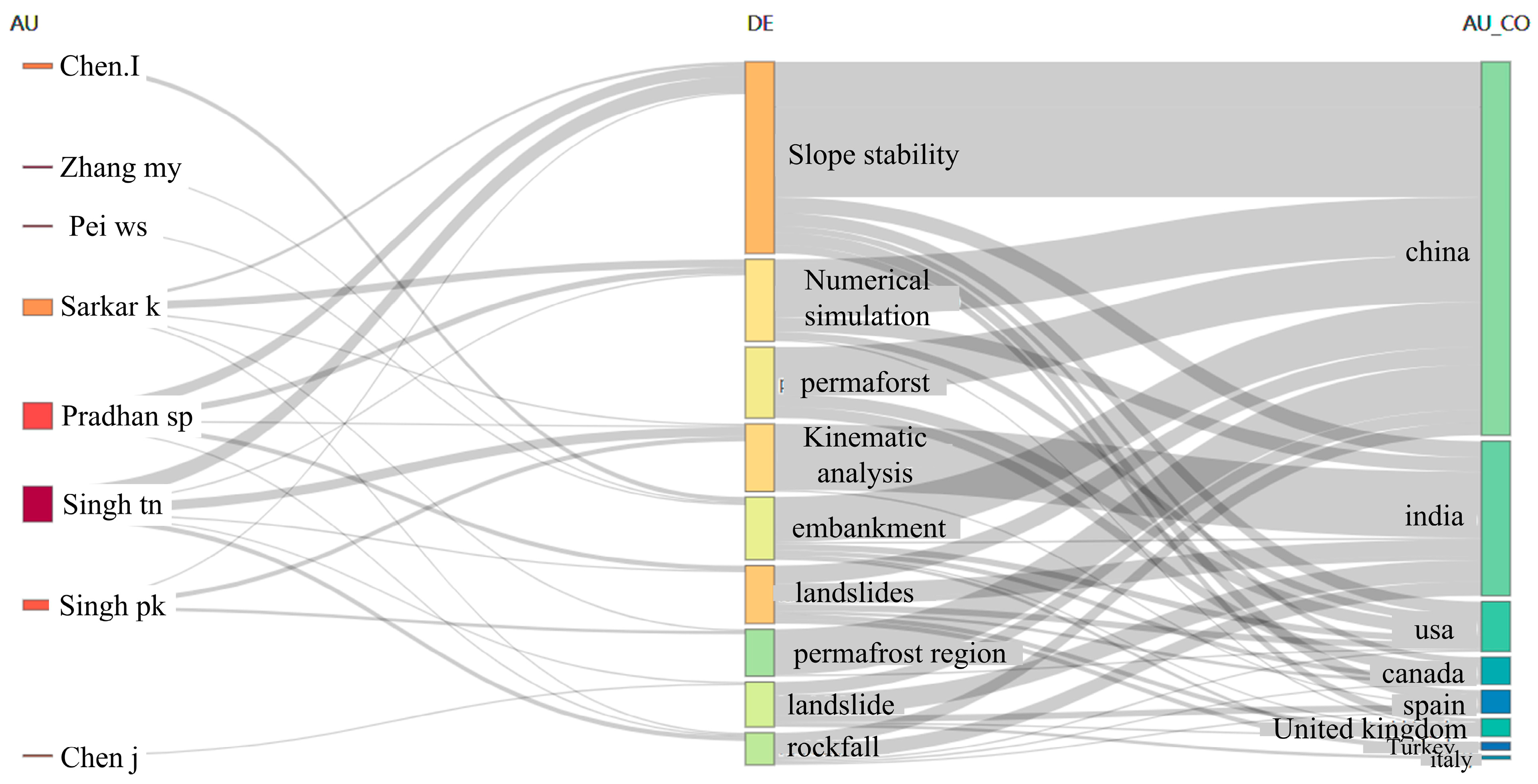
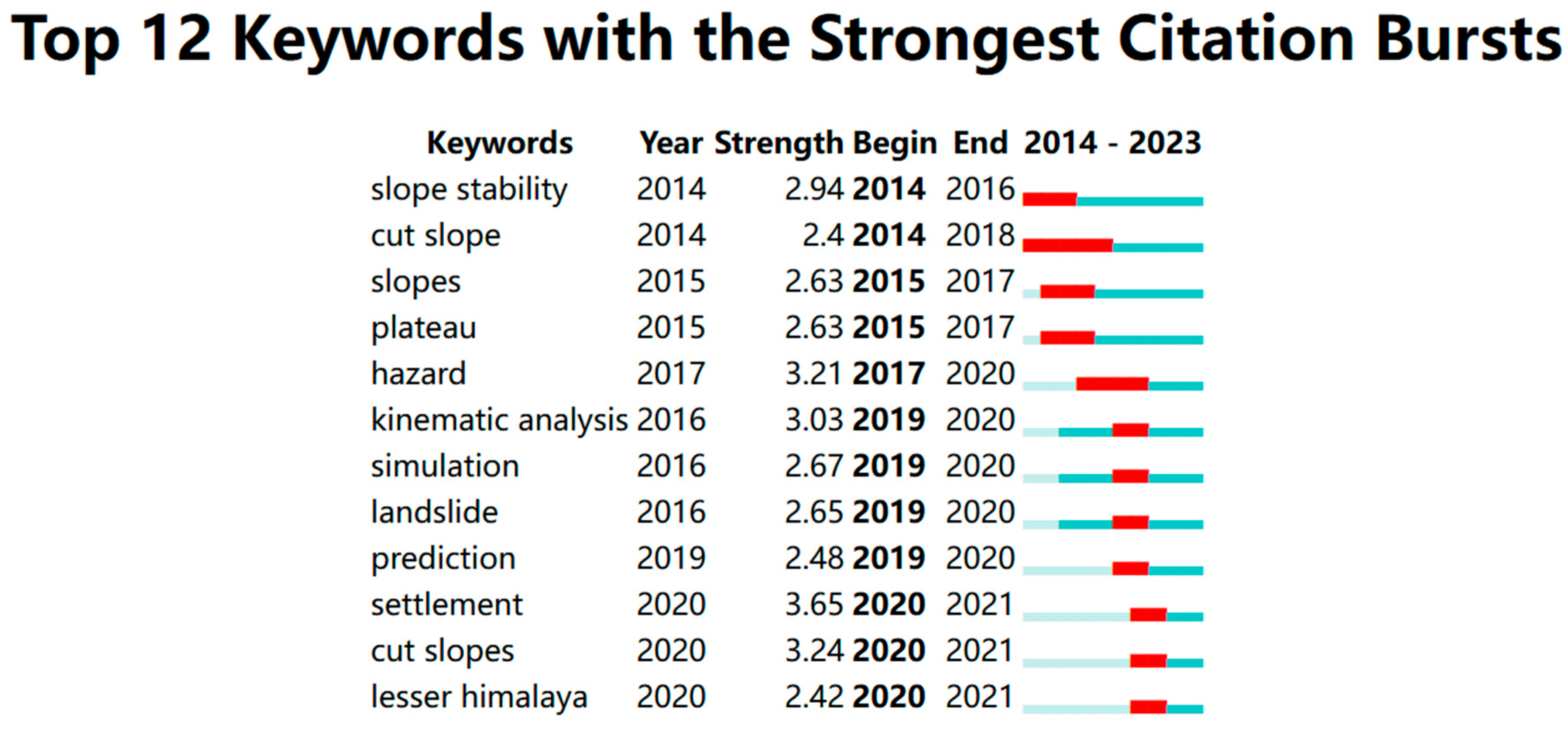
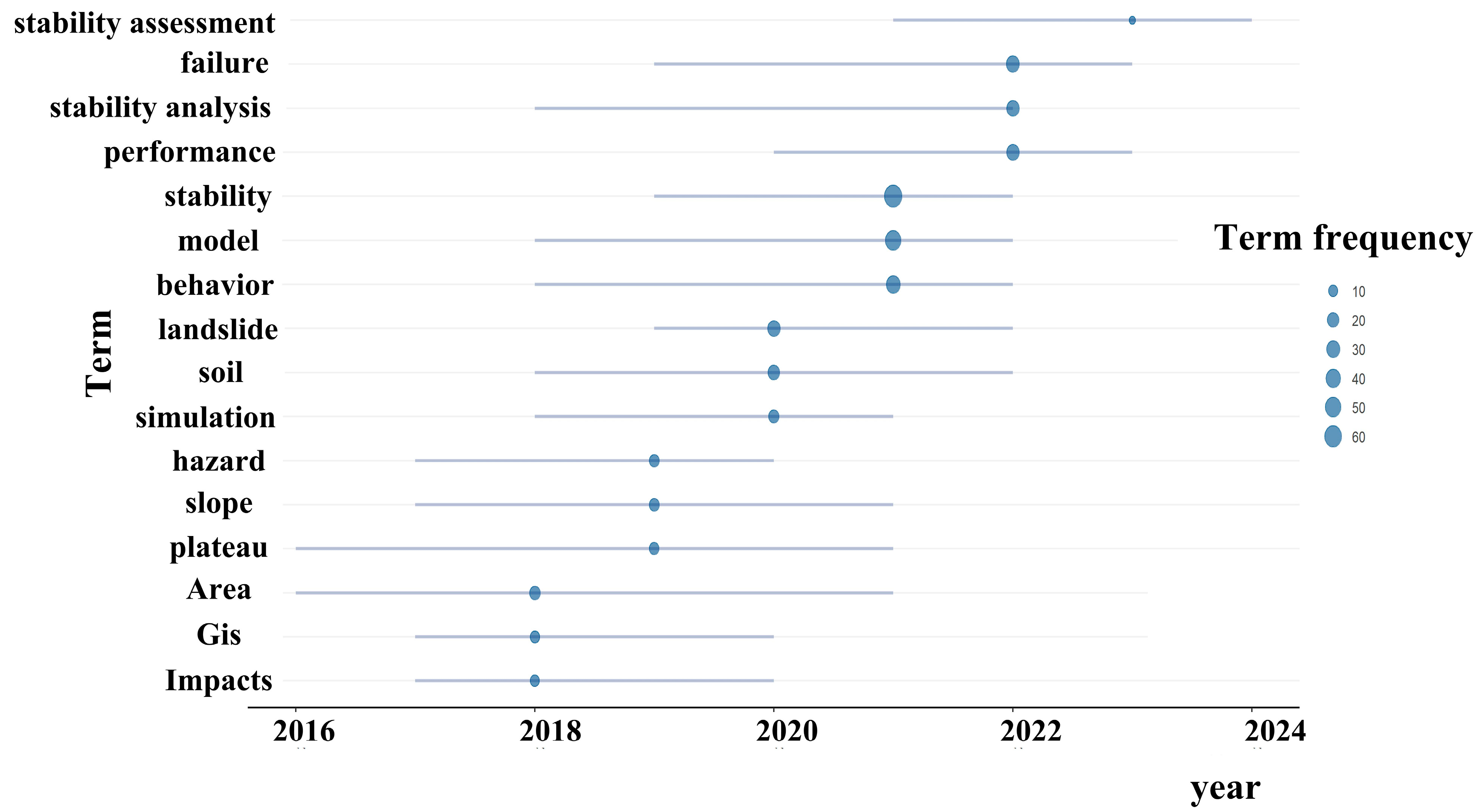
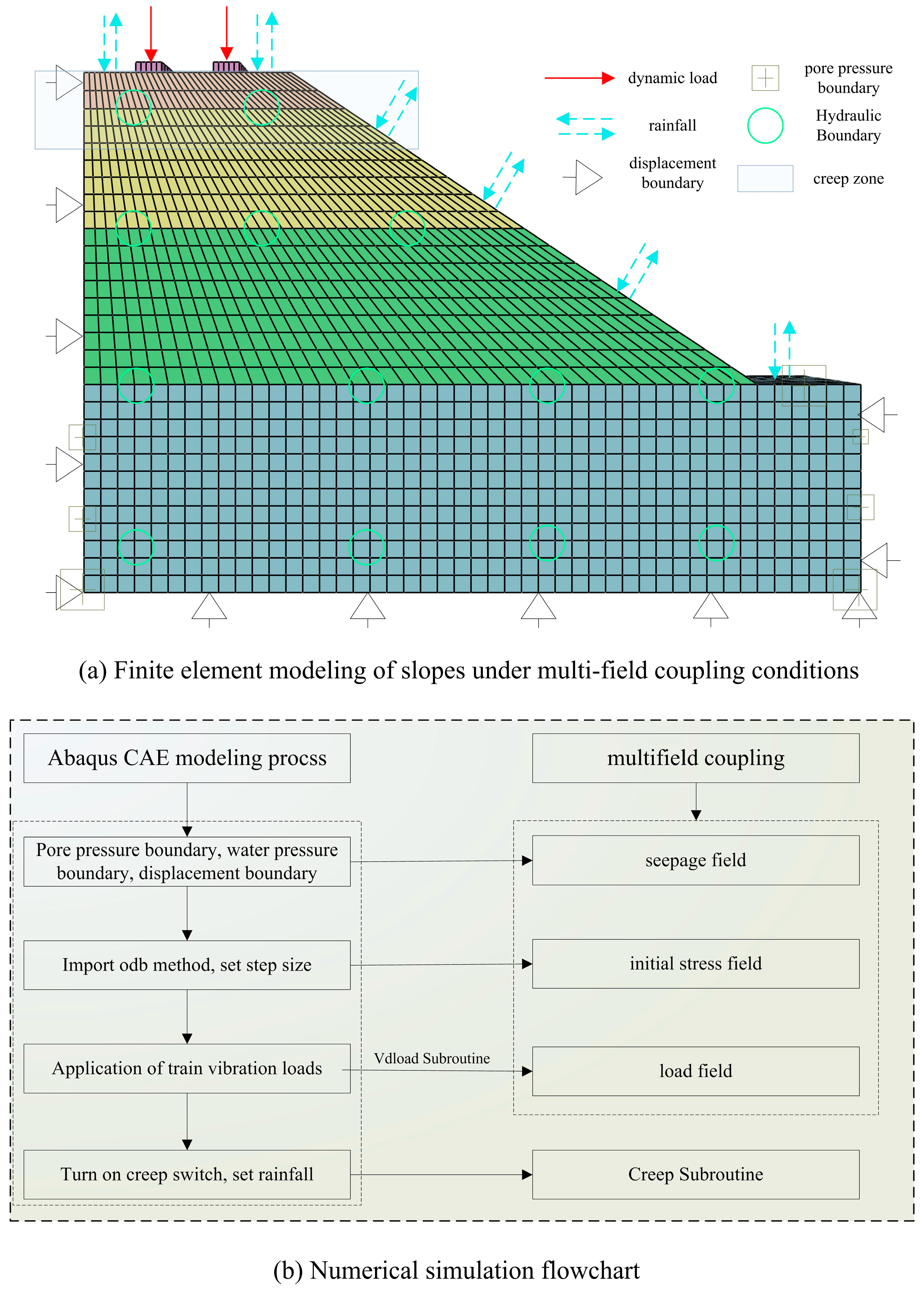
| Paper | References | TC | NTC |
|---|---|---|---|
| INTRIERI E, 2019, EARTH-SCI REV | [39] | 175 | 8.94 |
| CHAMBERS JE, 2014, NEAR SURF GEOPHYS | [40] | 121 | 3.41 |
| TANG L, 2018, COLD REG SCI TECHNOL-a | [41] | 108 | 4.70 |
| JAMSAWANG P, 2016, COMPUT GEOTECH | [42] | 105 | 3.93 |
| ZHANG MY, 2017, APPL THERM ENG | [43] | 99 | 3.56 |
| TCs: Total Citations; NTCs: Normalized Total Citations. | |||
| Document | References | LC | NLC |
|---|---|---|---|
| SINGH R, 2014, B ENG GEOL ENVIRON | [44] | 25 | 6.78 |
| SIDDIQUE T, 2017, ENVIRON EARTH SCI | [45] | 19 | 4.22 |
| BASAHEL H, 2017, J ROCK MECH GEOTECH | [46] | 15 | 3.33 |
| ZHANG MY, 2017, APPL THERM ENG | [43] | 15 | 3.33 |
| VISHAL V, 2017, NAT HAZARDS | [47] | 15 | 3.33 |
| KUNDU J, 2017, J EARTH SYST SCI | [48] | 13 | 2.89 |
| KAINTHOLA A, 2015, GEOSCI FRONT | [49] | 12 | 5.10 |
| PRADHAN SP, 2020, J ROCK MECH GEOTECH | [50] | 12 | 8.05 |
| LIU H, 2016, COLD REG SCI TECHNOL | [51] | 11 | 4.79 |
| SHARMA LK, 2017, J GEOL SOC INDIA | [52] | 10 | 2.22 |
| LCs: Local Citations; NLCs: Normalized Local Citations. | |||
| Authors | Articles | AF | TC |
|---|---|---|---|
| SINGH TN | 29 | 7.57 | 576 |
| ZHANG MY | 16 | 2.85 | 383 |
| AI YW | 14 | 1.78 | 225 |
| PEI WS | 11 | 2.01 | 320 |
| PRADHAN SP | 10 | 2.86 | 272 |
| TCs, Total Citations; AF: Articles Fractionalized. | |||
Disclaimer/Publisher’s Note: The statements, opinions and data contained in all publications are solely those of the individual author(s) and contributor(s) and not of MDPI and/or the editor(s). MDPI and/or the editor(s) disclaim responsibility for any injury to people or property resulting from any ideas, methods, instructions or products referred to in the content. |
© 2025 by the authors. Licensee MDPI, Basel, Switzerland. This article is an open access article distributed under the terms and conditions of the Creative Commons Attribution (CC BY) license (https://creativecommons.org/licenses/by/4.0/).
Share and Cite
Chen, J.; Xie, C.; Zhang, W.; Fu, C.; Shen, J.; Yang, B.; Li, H.; Shi, D. Current Status and Outlook of Roadbed Slope Stability Research: Study Based on Knowledge Mapping Bibliometric Network Analysis. Sustainability 2025, 17, 4176. https://doi.org/10.3390/su17094176
Chen J, Xie C, Zhang W, Fu C, Shen J, Yang B, Li H, Shi D. Current Status and Outlook of Roadbed Slope Stability Research: Study Based on Knowledge Mapping Bibliometric Network Analysis. Sustainability. 2025; 17(9):4176. https://doi.org/10.3390/su17094176
Chicago/Turabian StyleChen, Jiaozhong, Chengyu Xie, Wentao Zhang, Cun Fu, Jinbo Shen, Baolin Yang, Hannan Li, and Dongping Shi. 2025. "Current Status and Outlook of Roadbed Slope Stability Research: Study Based on Knowledge Mapping Bibliometric Network Analysis" Sustainability 17, no. 9: 4176. https://doi.org/10.3390/su17094176
APA StyleChen, J., Xie, C., Zhang, W., Fu, C., Shen, J., Yang, B., Li, H., & Shi, D. (2025). Current Status and Outlook of Roadbed Slope Stability Research: Study Based on Knowledge Mapping Bibliometric Network Analysis. Sustainability, 17(9), 4176. https://doi.org/10.3390/su17094176








